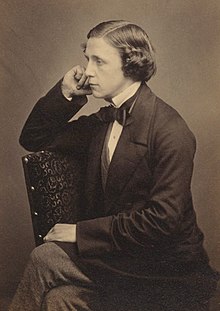
Back Lewis Carroll AF Lewis Carroll ALS Lewis Carroll AN لويس كارول Arabic لويس كارول ARZ Lewis Carroll AST Luis Kerroll AZ لوئیس کارول AZB Льюис Кэрролл BA Льюіс Кэрал BE
Lewis Carroll | |
|---|---|
 Carroll in 1857 | |
| Born | Charles Lutwidge Dodgson 27 January 1832 Daresbury, Cheshire, England |
| Died | 14 January 1898 (aged 65) Guildford, Surrey, England |
| Resting place | Mount Cemetery, Guildford, Surrey, England |
| Occupation |
|
| Education | |
| Genre | |
| Parents | Charles Dodgson (father) Frances Jane Lutwidge (mother) |
| Relatives |
|
| Signature | |
Charles Lutwidge Dodgson (/ˈlʌtwɪdʒ ˈdɒdsən/ LUT-wij DOD-sən; 27 January 1832 – 14 January 1898), better known by his pen name Lewis Carroll, was an English author, poet, mathematician, photographer and reluctant Anglican deacon. His most notable works are Alice's Adventures in Wonderland (1865) and its sequel Through the Looking-Glass (1871). He was noted for his facility with word play, logic, and fantasy. His poems Jabberwocky (1871) and The Hunting of the Snark (1876) are classified in the genre of literary nonsense. Some of Alice's nonsensical wonderland logic reflects his published work on mathematical logic.
Carroll came from a family of high-church Anglicans, and pursued his clerical training at Christ Church, a constituent college of University of Oxford, where he lived for most of his life as a scholar, teacher and (necessarily for his academic fellowship at the time) Anglican deacon. Alice Liddell – a daughter of Henry Liddell, the Dean of Christ Church – is widely identified as the original inspiration for Alice in Wonderland, though Carroll always denied this.
An avid puzzler, Carroll created the word ladder puzzle (which he then called "Doublets"), which he published in his weekly column for Vanity Fair magazine between 1879 and 1881. In 1982 a memorial stone to Carroll was unveiled at Poets' Corner in Westminster Abbey. There are societies in many parts of the world dedicated to the enjoyment and promotion of his works.[1][2]
- ^ "Lewis Carroll Societies". Lewiscarrollsociety.org.uk. Archived from the original on 29 March 2016. Retrieved 7 October 2020.
- ^ Lewis Carroll Society of North America Inc. Archived 26 March 2022 at the Wayback Machine Charity Navigator. Retrieved 7 October